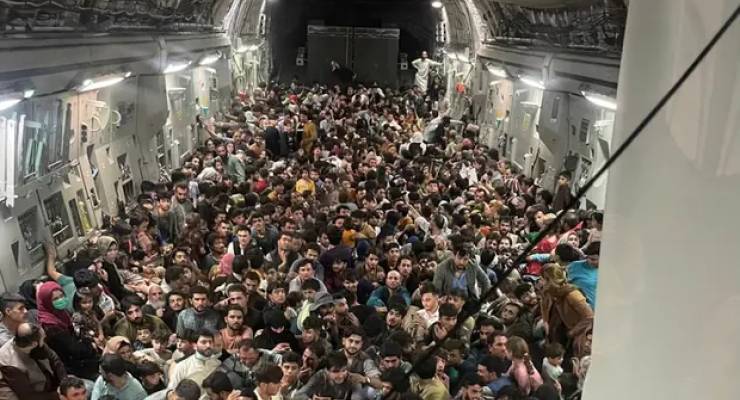
As the Taliban called for calm in a press conference, a single photograph became a defining moment: a US military aircraft, with a usual capacity of 134, stacked with 640 fearful Afghans fleeing persecution from their deadly new leadership.
But when an Australian Defence Force aircraft that can take 128 people left Kabul yesterday it had more than 100 empty seats. Prime Minister Scott Morrison has committed to resettling 3000 Afghans, but allies like the UK, the US and Canada have committed to take 20,000 each. What gives?
Foreign planes flying out of Afghanistan have started landing at home carrying citizens and Afghans. As Australia evacuated 26 people, Germany took 131, and a Dutch flight departed with 40 on board. Among the 26 on the ADF plane were Australians, Afghans with approved visas and one foreign official.
Elaine Pearson, the Australian director of Human Rights Watch, described the ADF’s spare seats as “so disappointing”.
“Every seat should be filled — Afghanistan is in crisis, military planes are the only ones that are leaving,” she said. “Security vetting can be done in third countries. [There are] so many Afghans at risk.”
But yesterday Defence Minister Peter Dutton claimed some former interpreters who’d worked with Australia may have switched allegiances to the Taliban.
“The reality is people just for their own survival instincts move allegiances around,” he said. “There are people who have helped out at a point in time who have since acted out against our interests.”
Dutton also said some visa applicants had tried to get protection from various Western countries, and accused them of “forum shopping”.
“Australia has done more than almost any other country in the world in terms of the number of locally engaged employees and their family members that we’ve brought to our country,” Dutton said.
The numbers show this is untrue. British Home Secretary Priti Patel said the UK was evacuating 1000 people a day but was forced to defend the government’s 20,000-person commitment. Labour leader Sir Keir Starmer called the 20,000 target “too small” and described it as “plucked out of the air”, but Patel responded that it may end up being many more.
She said women, girls and persecuted minorities will make up the bulk of those resettled in the UK as she cast doubt on the Taliban’s claim that women will have rights under sharia law. The 20,000-strong commitment is on top of an existing scheme in the UK — the Afghan relocations and assistance policy — which has seen 2000 Afghans and their families arrive in the UK since June.
Canada welcomed 23,000 Afghan refugees between 2001 and June 2021, but will nearly match now that amid the unfolding crisis. Prime Minister Justin Trudeau, who’s on the campaign trail, said Canada would not recognise the Taliban as the country’s government. Some are drawing parallels between the 2015 election, when a boy who washed up on a beach became the defining image of Syria’s refugee crisis.
The emotional response saw Canada resettle 73,000 Syrians (Australia took about 12,000). The Canadian government has created a special immigration program for Afghans who helped Canadian troops, and said it would prioritise women, human rights defenders, journalists, persecuted religious minorities, LGBTIQ individuals, and family members of previously resettled interpreters.
In the US, more than 300,000 Afghan civilians have been affiliated with the Americans over 20 years in the country, but not all will qualify for resettlement. The US has evacuated 2000 Afghans since July, but it’s heating up — about 700 people have been evacuated in the past 24 hours, a Pentagon official said.
The Taliban vowed there would be no revenge on the US or those who have worked with it but experts reckon they face the risk of grave retribution. Fortunately, bipartisan special visa programs have long given workers in Afghanistan a path to legal residency in the US. Congress passed the programs in 2002 and, although there are sometimes years-long delays, they’ve managed to resettle about 15,000 Afghans. They do not count in the US’s total refugee commitment each year.
The Australian government says it has granted more than 8500 visas to Afghans through Australia’s humanitarian program in the past eight years. More than 400 Afghans who worked with Australia in Afghanistan have arrived in the country with their families since April, and more ADF planes are due to land in Afghanistan.
But Morrison threw a bucket on hopes Australia would match the compassionate commitment of the UK, the US and Canada on Wednesday. “Australia is not going into that territory,” he said, adding he planned to follow the existing UN commitment and approve up to 3000 Afghan visas.
However, there will be no special visa programs — his commitment is not in addition to Australia’s yearly refugee quota, which was slashed at last year’s budget from 18,750 a year to 13,750. Worse, Australia’s refugee quotas are rarely met. In 2018, when we ranked 50th in the world for our per-capita refugee intake, we took 12,706 total refugees in. In 2019, it was 14,993 people. Yet UNHCR says there are 4.1 million asylum seekers worldwide.
Dutton, meanwhile, hit out at other countries, claiming many had made big refugee commitments in the past but failed to follow through: “Let’s see whether people put their money where their mouth is.”
Although international law says that seeking asylum is every human’s right, the Morrison government has maintained “illegal” terminology to describe the government’s rigid attitude towards refugees — particularly people who arrive by boat.
Morrison said yesterday: “We will not be allowing people to enter Australia illegally even at this time”, and that officials would “check the bona fides of individual applicants”.
He added that Afghans who remain in limbo in Australia’s detention system would continue to be denied permanent resettlement.









The Taliban are more trustworthy than minister potato head.
The Taliban and the Morri$sinner regime have a lot in common.
be careful THE SPUD may sue for defamation.
Australia, in my humble experience, is very fond of ‘blowing its own trumpet’. We are constantly bombarded with ‘world-class’ ‘best there are’ statements. Never any evidence, just trumpet blowing. As for the man who notionally leads that blowing, Scott ‘SmoCo’ Morrison, he’s a reactive follower, not a dynamic, inspiring leader. He’s never out front, always lagging, always watching how others do it. I think it’s time for change to both things. So, If you want to blow your trumpet, do something that makes people sit and take notice and ‘wow!’, instead of slinking lower in their chair and going ‘oh, no, really…’
That’s not a trumpet.
You’re right, Richard. I’ve always said there is something at which Australia is definitely world’s best, and that is self-congratulation, generally when it’s unjustified.
What shallow, hollow men Morrison and Dutton are! These pathetics just have to go next election!
Australia appears to be an under-performer in significant areas ie: ethical climate policy, vaccination purchase/distribution & in humanitarian matters.
We engaged in a 20-year war however, according to Dutton, now cannot trust Afghanis upon whom the ADF once relied. Dutton claims some have switched allegiances. But even if they haven’t, his bottom line suggests they are stuffed.
It remains a mystery why the Morrison government is so pleased with itself while our nation slips backwards at speed. The term ‘proud Australian’ is sounding self-contradictory.
Dutton hitting out at Afghani people and other countries’ rescuing them; you just can’t trust any of them, mate.
Now there is a case of cynical projection of one’s own tendencies if ever I’ve seen one. What an absolute…